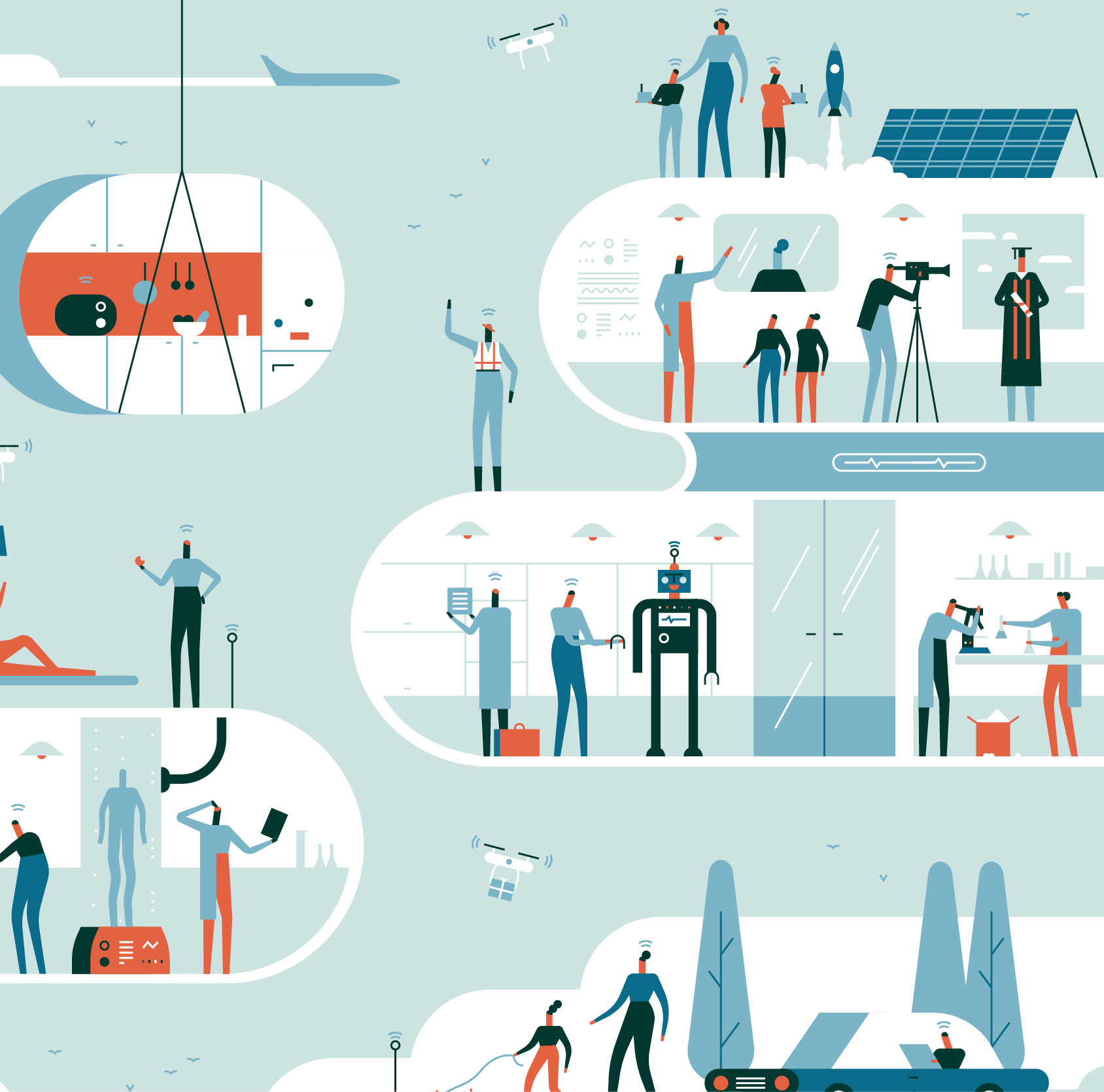by Mason Adams, Marya Barlow, and Eleanor Nelsen
photos by Logan Wallace | illustrations by MUTI
On a day in the near future, in the dark hour just before dawn, automated lights illuminate the room, waking you gently. You summon your digital assistant to review the day’s schedule and to monitor your home’s energy consumption. Ready for work, you step into an autonomous car that slides into a self-organizing caravan on the interstate, giving you time to read email and catch up on the news.
At the office, after a busy morning, you order lunch. The meal arrives at your desk minutes later, delivered by drone. Later that evening, as you return home, sensors recognize your arrival, bringing up the lights. You prepare dinner, remembering to scan each ingredient. The grocer will deliver a new order on Friday.
Before settling in for the night, you check in with your digital assistant, confirming that your elderly mother has taken her medicine. As you slip into bed, the lights dim automatically, and soothing music pipes in to help you relax.
Once dismissed as science fiction, such a scenario is an advancing reality. Smart devices, including digital assistants and home energy monitors, are already available. Businesses are field-testing the digital networking of the not-so-distant future, and lawmakers are wrestling with policies to manage consumer security, safety, and privacy in this changing environment.
Capitalizing on existing strengths, Virginia Tech is driving the research and technology even further, becoming a global leader in the developing field through the university’s Destination Area known as Intelligent Infrastructure for Human-Centered Communities (IIHCC).

Last year, the university announced it plans to invest $78.45 million over five years to build capacity in intelligent infrastructure disclipines, such as smart design and construction, and autonomous vehicles that navigate land, air, and water.
“The commitment across campus to create a unique and valuable living-learning experience for our students is extraordinary,” said Virginia Tech President Tim Sands. “We expect more than 2,000 students to be involved in intelligent infrastructure study and research by 2022.”
More than 230 faculty members from multiple colleges and institutes are involved as the university ties new assets into existing programs and research facilities across the Blacksburg campus to create an unparalleled educational experience.
“When someone is doing research or getting a degree or coming to work on a topic, we’re not specializing with a widget—we are now solving a problem,” said Myra Blanco, advanced-vehicle researcher at the Virginia Tech Transportation Institute; director of the Center for Public Policy, Partnerships, and Outreach; and former chairwoman of the IIHCC stakeholder group.
“Students come to Virginia Tech for its reputation and then get immersed into the Virginia Tech way,” said Blanco (M.S. industrial and systems engineering ’99, Ph.D. ’02). They can participate in a real project funded by the government, and they are also able to participate in proprietary research. We’re allowing them to participate in all of that with professors and researchers who are exposing them to something more than just being in a classroom. When they graduate, they are going to be well prepared to tackle any problems they may have in real life.”
The Destination Area is based around four themes: energy, robotics and autonomous vehicle systems; smart design and construction; and ubiquitous mobility—anywhere connectivity that brings the world to the individual who may be hindered by physical limitations.
“Everything is glued together with human-centered communities,” said Blanco. “It’s not pushing technology for technology’s sake; it’s to improve quality of life, to improve equality, and to ensure at the end of the day that we have a healthier community.”
Energy is similarly important as an underlying concept. As communities become increasingly mobile and data-driven, how will they be powered in a sustainable way? Virginia Tech faculty and students already engage on the cutting-edge of energy research through competitions like the Solar Decathlon and institutions such as the Virginia Tech Center for Power Electronics Systems, which partners with more than 90 industrial affiliates.
“With all of the activities involved, energy must be available and flow seamlessly and transparently between systems,” said IIHCC Program Manager Tracy McElroy. “Energy ties all of this together.”

In late July, Torc Robotics’ Lexus RX hybrid completed an autonomous drive of more than 4,300 miles from Virginia to Seattle and then back to Richmond. Gov. Terry McAuliffe was there to greet its return. “I am proud to see a homegrown engineering firm develop self-driving technology and introduce it to the rest of the country on a coast-to-coast drive,” McAuliffe said. “This technology is coming, and we want to be in front of it here in Virginia. We want to be the leader.”
Virginia plans to install about 85 miles of sensors for autonomous vehicles along I-95 near the National Capital Region. The private company, Uber, invested millions into a real-world test of driverless cars in Pittsburgh, Pennsylvania, over the past two years, and commercial car makers are investigating the use of automated driving systems as well.
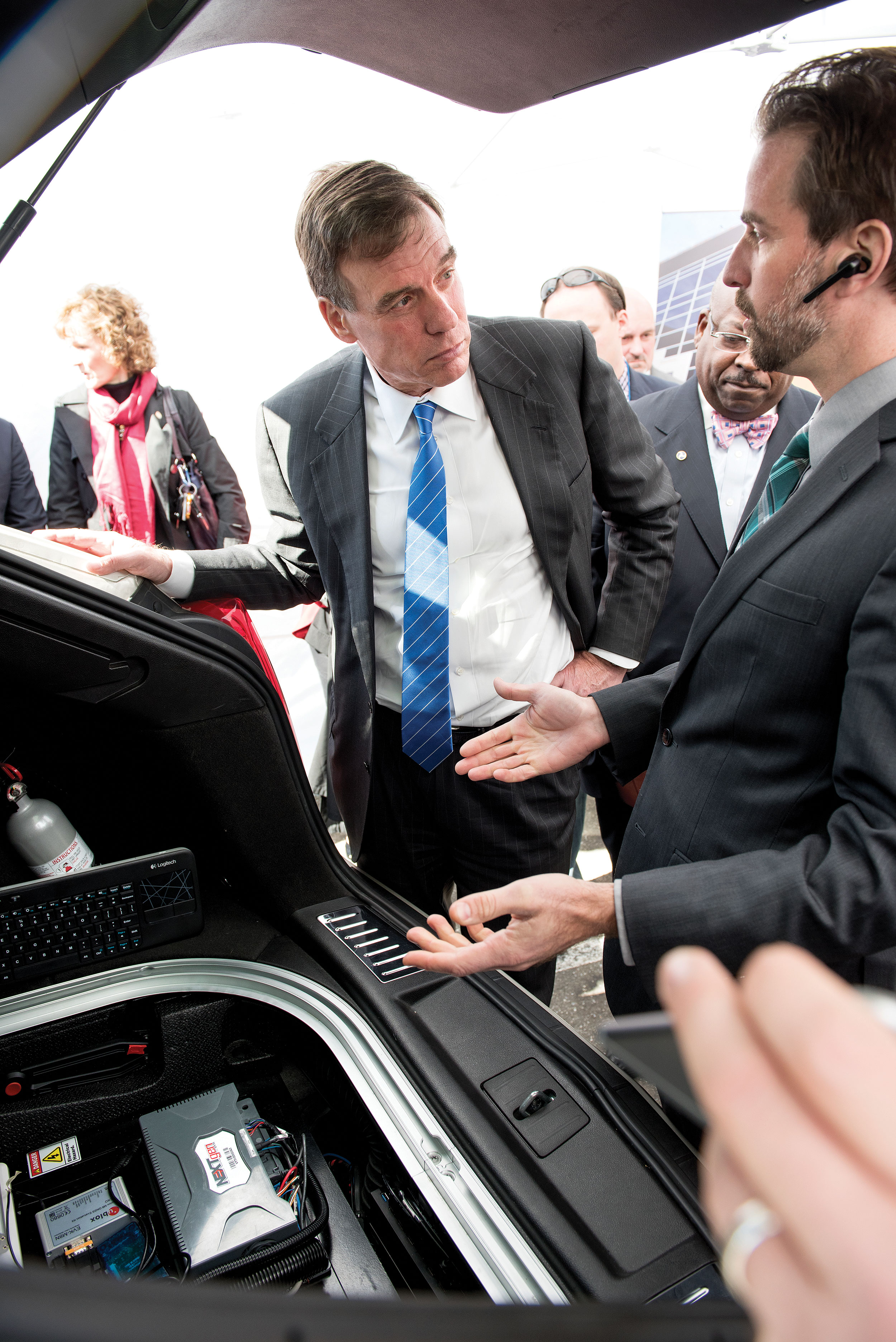
In fall 2015, Sen. Mark Warner attended a special demonstration of autonomous and connected vehicles hosted by the Virginia Tech Transportation Institute in Arlington, Virginia. (photo by Logan Wallace)
Hokie-run, Blacksburg-based Torc is making a big splash in this world. Tech publication TechCrunch noted Torc’s arrival among the businesses offering self-driving car technology to carmakers, indicating that “this one likely has a bit more experience than most.”
Torc’s vehicle traveled across 20 states as part of the Seattle trip. The car drove all but about 1,000 miles; occasionally, one of three standby drivers took the wheel because of traffic obstacles orvarying autonomous vehicle certification requirements in each state.
More than half of the Torc’s employees are Virginia Tech alumni, including its CEO, Michael Fleming (mechanical engineering ’02, M.S. ’03). Fleming co-founded Torc in 2005, after participating on a Virginia Tech team that won an intelligent ground vehicle competition five years in a row, as well as placing two vehicles in the top 10 among 195 entrants in the 2005 Defense Advanced Research Projects Agency (DARPA) Grand Challenge.
Frustrated by seeing a recurring cycle in which students and professors grew to collaborate at a high level, only for the students to move on after graduation, Fleming remained in Blacksburg to break that pattern and continue the work.
“The autonomous vehicle team worked right beside the Baja team, right beside the sub team and the bridge team,” Fleming said. “We spent endless nights and weekends building and breaking and rebuilding things. That’s where a lot of education takes place. It takes place in the classroom, too, but it’s also important for students to apply engineering know-how and for teams to figure out what works and what doesn’t work.”
Virginia Tech and Torc have collaborated on more than $10 million worth of research and development that could lead to driverless cars entering the consumer market in a matter of years.
But technology development is just one aspect of the growing autonomous vehicle industry. The Virginia Tech Transportation Institute (VTTI) plays a significant role in related research, testing not just vehicle capacities but also the social effects of driverless cars. VTTI research on the reaction of motorists to driverless cars went viral in August, when an apparently driverless gray van drew the attention of people in Arlington, Virginia. A reporter chased down the van, exposing the driver, who was disguised as the seat.
Although there has been tremendous progress in the industry in recent years, Virginia Tech and allied partners like Torc have only begun to scrape the surface of what’s possible.
“I’ve worked in this space for a decade,” Fleming said. “I think about self-driving impact in society every day, and I still don’t comprehend the impact it’s going to have. Who would’ve thought that we could pay our taxes, order pizza, and find a date when cell phones were first invented? Self-driving vehicles will have that similar impact.”
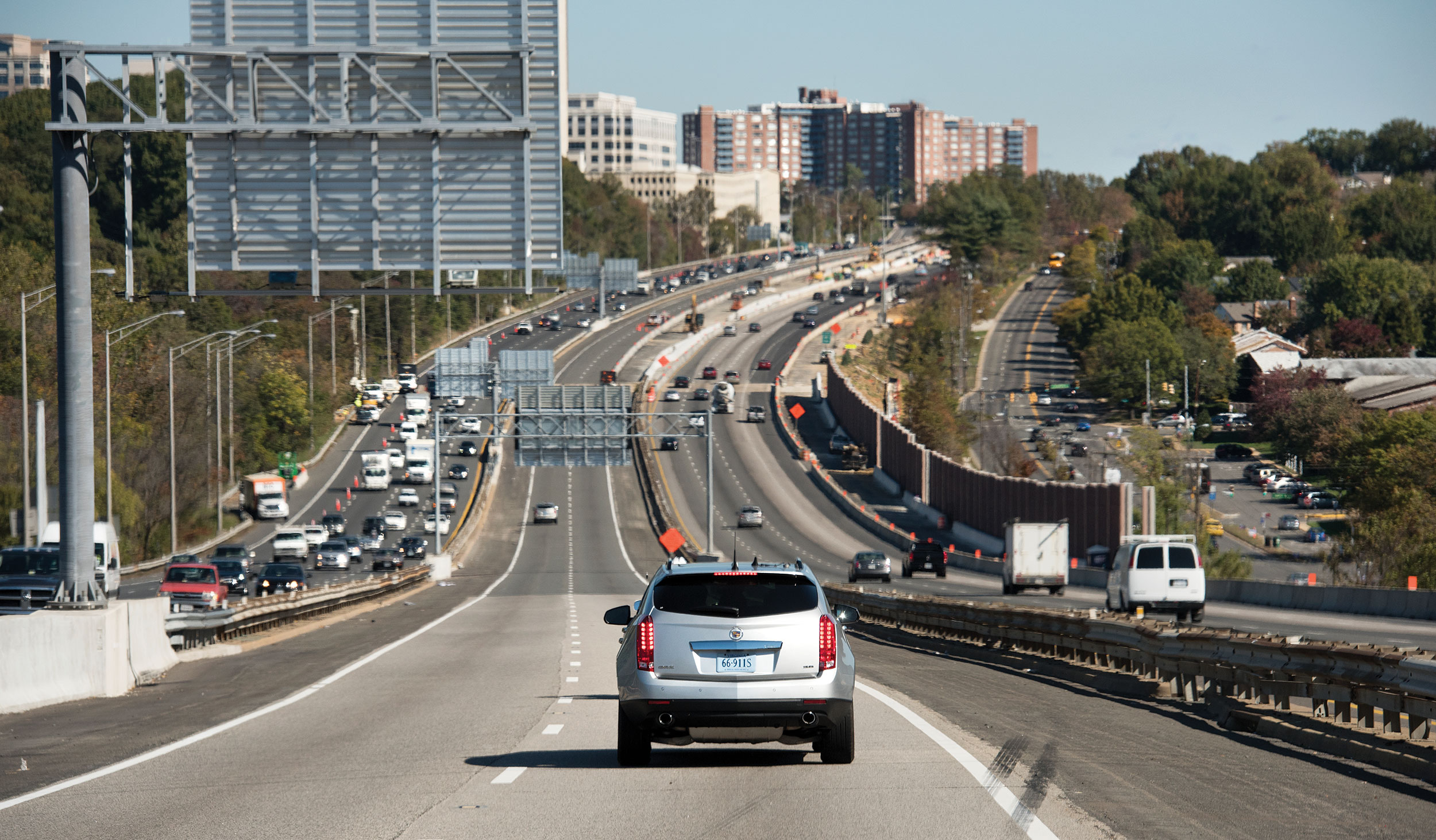
Testing is already underway to determine the role of driverless cars and advanced vehicle connectivity in improving urban traffic safety in Arlington, Virginia. (photo by Logan Wallace)

Virginia Tech students, researchers, and staff gathered near campus a year ago to place a special lunch order from Chipotle Mexican Grill. The novelty of burritos, chips, and salsa delivered by an unmanned aerial system (UAS), or drone, drew the interest of individuals across campus. The project resulted from a partnership between Virginia Tech Mid-Atlantic Aviation Partnership and Project Wing, which is part of X, an innovation lab formerly known as Google[x] that incubates breakthroughs in science or technology.
The flights marked two firsts for Project Wing—involving external users in the U.S. and collaborating with a Federal Aviation Administration (FAA)-approved unmanned aircraft systems test site.
In June, Virginia Tech and Project Wing, along with other partners, field-tested technology developed by NASA that is designed to allow multiple aircraft to safely share the same airspace.
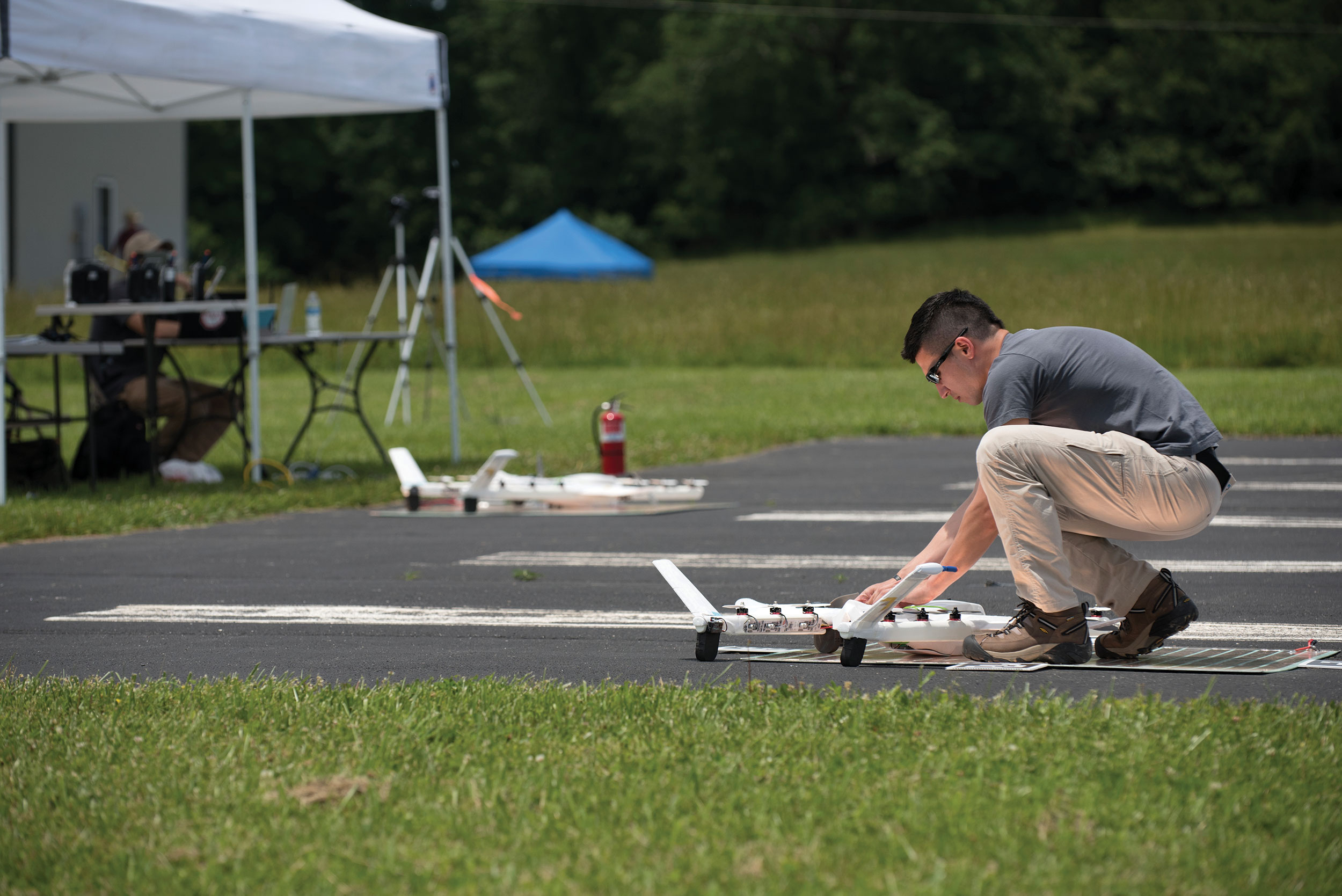
In June, the Virginia Tech Mid-Atlantic Aviation Partnership and commercial partners, including Project Wing, field-tested NASA’s traffic management system for unmanned aircraft. (photo by Althea Olinger)
There is no shortage of “dull, dirty, and dangerous” tasks that drones can handle much more safely and efficiently than a human in a helicopter—jobs like inspecting bridges and powerlines or delivering emergency medical supplies after natural disasters. As use of the UAS becomes more common for commercial and other purposes, a variety of aircraft controlled by different operators conducting unrelated missions will increasingly share airspace. The rigorously choreographed June operation explored scenarios that may arise as UAS flights become commonplace.
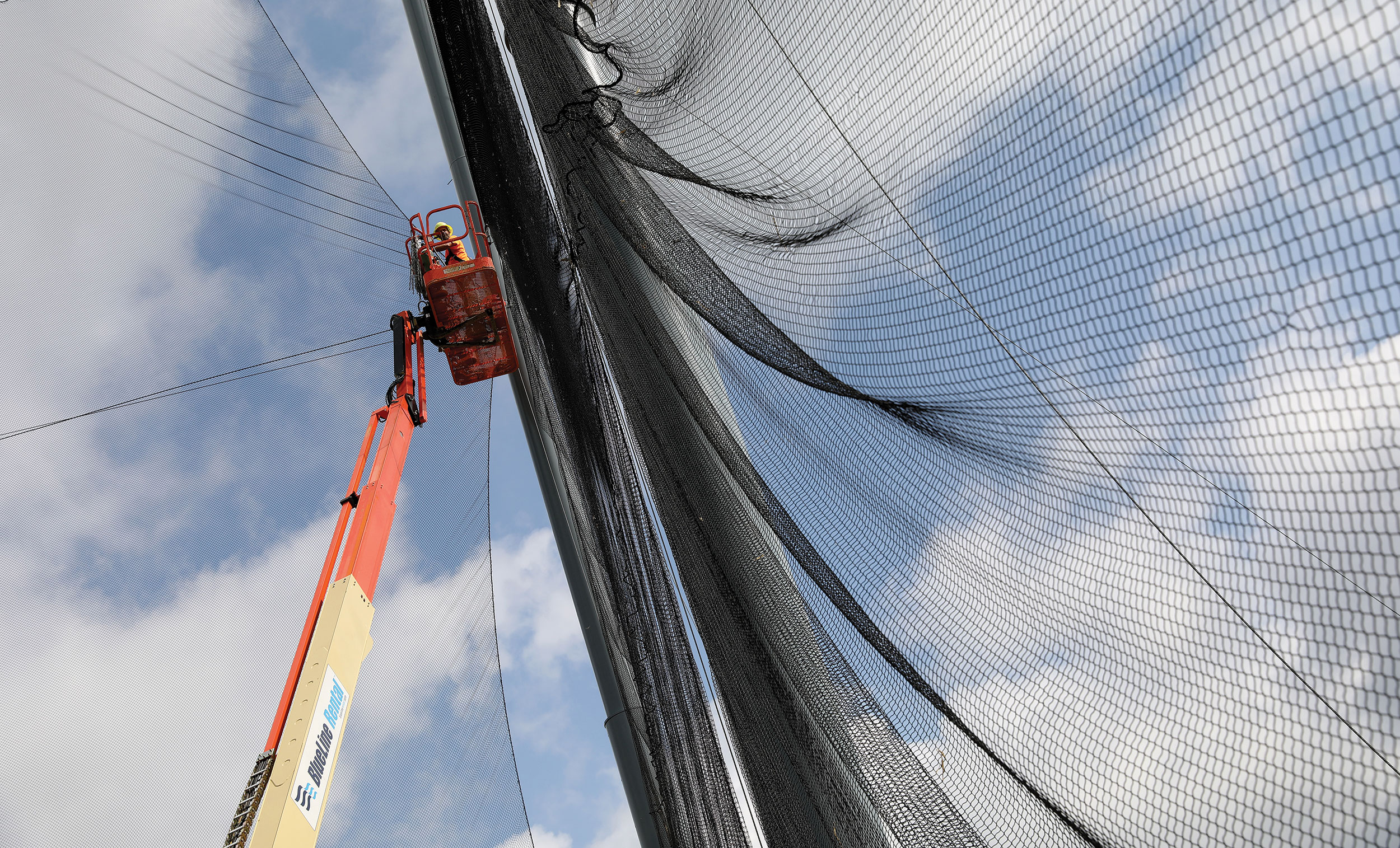
This fall, Virginia Tech began construction of an innovative testing ground for students and researchers to fly unmanned aerial vehicles. Located on Oak Lane, the netted facility will measure 300 feet by 120 feet when complete, making it the tallest drone park in the country. (photo by Ray Meese)
The test site at Virginia Tech is one of seven in the U.S. approved by the FAA for tests of unmanned aircraft. The Mid-Atlantic Aviation Partnership (MAAP), which runs the site, works with researchers, government agencies, and companies ranging from UAS startups to major corporations like Intel and Dominion Energy.
“These aren’t speculative research projects that may come to fruition 15 or 20 years in the future—these are companies who want to operate this year or next year,” said Mark Blanks, director of the Virginia Tech MAAP. “It’s not an overstatement to say that Virginia Tech is the laboratory where we’re mapping out the future of unmanned systems. It’s an incubator not just for the technology, but also for the regulations and guidelines that will determine what operations people are going to be allowed to do.”
MAAP is collaborating with Virginia Tech’s world-renowned injury biomechanics program to quantify the injury risk associated with drone-human impacts. The FAA won’t allow commercial drone flights over people until companies can demonstrate that there’s little or no risk to people on the ground—a major roadblock for applications like package delivery. Currently, the empirical data to assess such risks doesn’t exist. MAAP and the injury biomechanics team are designing test methods and running the experiments that will begin to answer those questions.
For a physical manifestation of the university’s commitment to UAS research, you don’t have to look any farther than Oak Lane, where a netted, 80-foot-tall drone park now overlooks the golf course.
The structure will offer nearly three million cubic feet of outdoor flight space that gives researchers access to real-world wind and weather conditions, enclosed by a net that means the airspace isn’t subject to FAA regulations. A space for education and research in addition to recreation, it will be adjacent to classroom and lab space where students can work on original projects and learn how to use drones safely for applications from journalism to agroforestry.
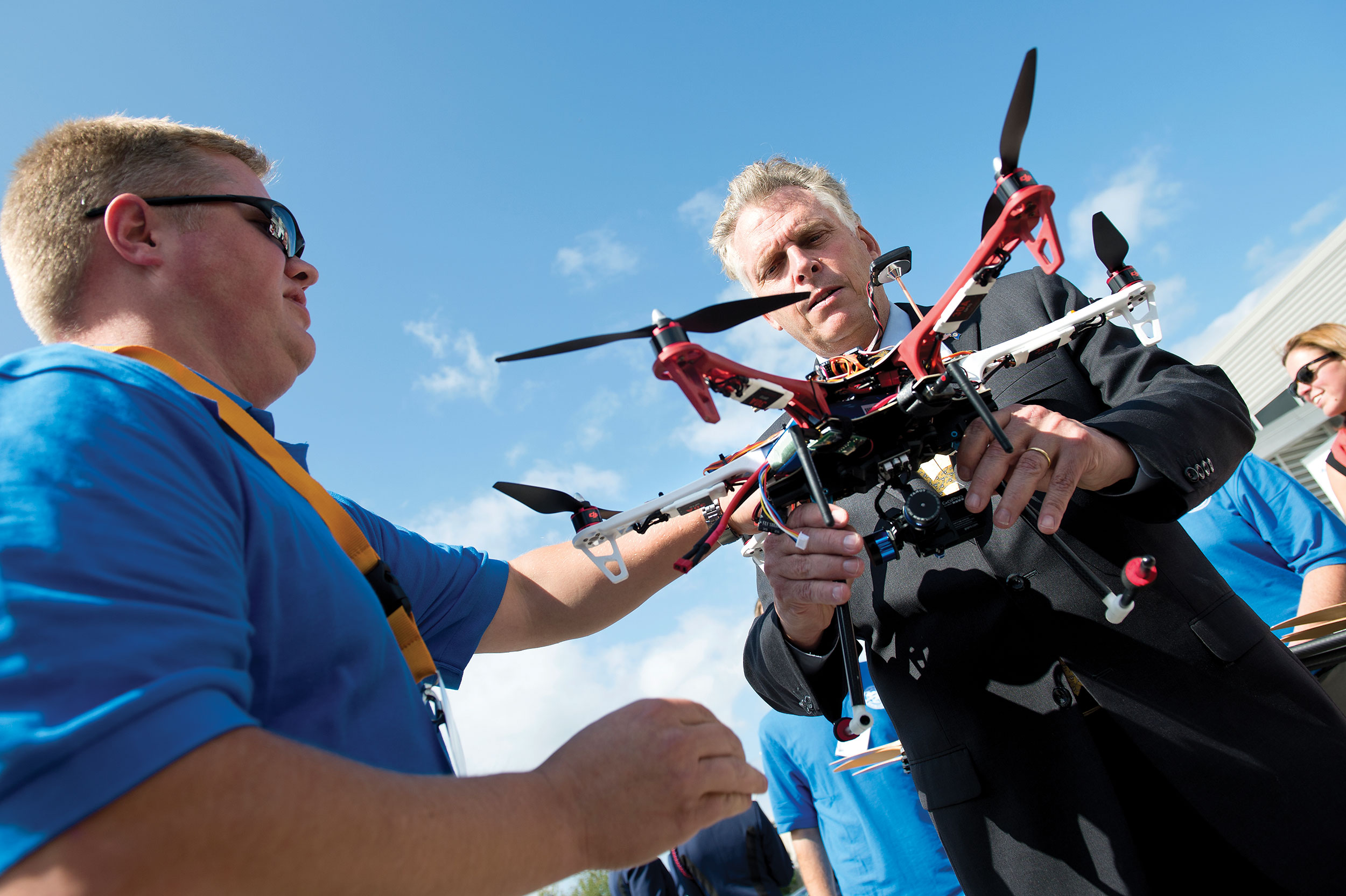
Virginia Gov. Terry McAuliffe closely examines a drone following a drone demonstration held in August 2014 at the Smart Road. The demonstration was part of a special media event at the Virginia Tech Transportation Institute celebrating the university’s unmanned aerial system test site. (photo by Logan Wallace)
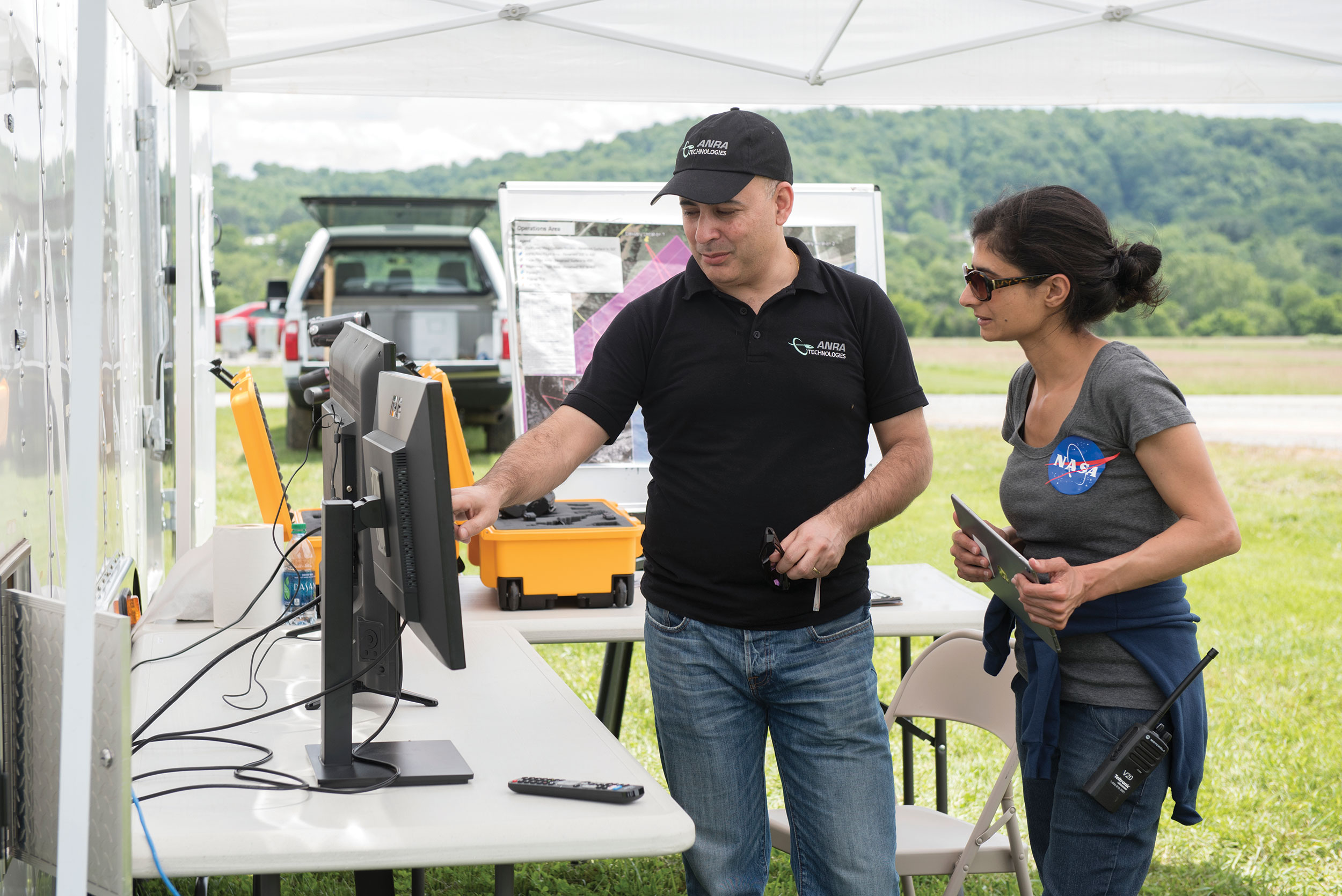
This summer, representatives from the Mid-Atlantic Aviation Partnership, NASA, and Project Wing studied software designed to allow multiple craft to share airspace safely. (photo by Altheah Olinger)
“It’s not an overstatement to say that Virginia Tech is the laboratory where we’re mapping out the future of unmanned systems.”
—Mark Blanks,
director of the Virginia Tech MAAP

Picture a high-tech, high-quality LEGO kit that allows you to build a home within the cost and spatial parameters of your lifestyle. That’s what a team of faculty-student researchers led by Professor Joe Wheeler in the College of Architecture and Urban Studies (CAUS) has been developing. But unlike LEGOs, the effort is not child’s play. “We’re working on housing solutions to meet a world population and climate change crisis,” Wheeler said.
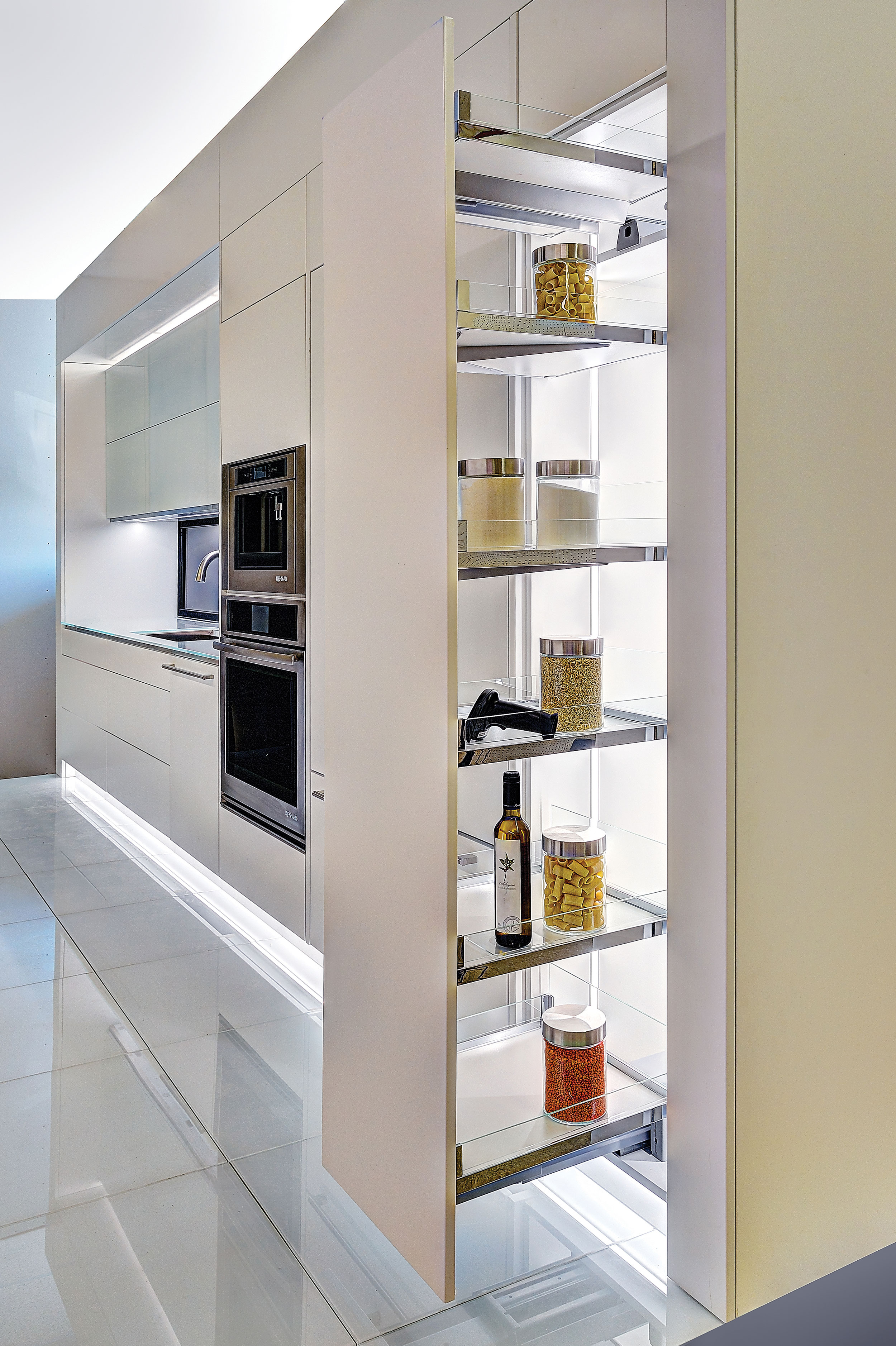
The kitchen pantry of the future may be equipped with scanning devices to communicate updates to grocery orders in real time. (photo by Jim Stroup)
“Our planet will grow by over 2 billion people before 2050, and we need to be ready with practical, affordable housing.” Wheeler, co-director of Virginia Tech’s Center for Design Research,calls the solution the “cartridge concept.” The concept borrows the best of factory and assembly line processes to connect modular building with sleek futuristic design, smart technology, and sustainability.
The research is being explored for uses ranging from homes and condos to hospitals, hotels, and disaster relief shelters, attracting interest from world-leading architecture firms, consumer brands, and foreign and domestic governments.
In July, the U.S. Department of Housing and Urban Development met with the team to learn how Virginia Tech’s research could be adapted for disaster relief shelters and low-income single and multifamily homes. At the event, a student-led demonstration showcased the benefits of the concept. The students unloaded components and deployed a 288-square-foot disaster relief prototype house in under two hours.
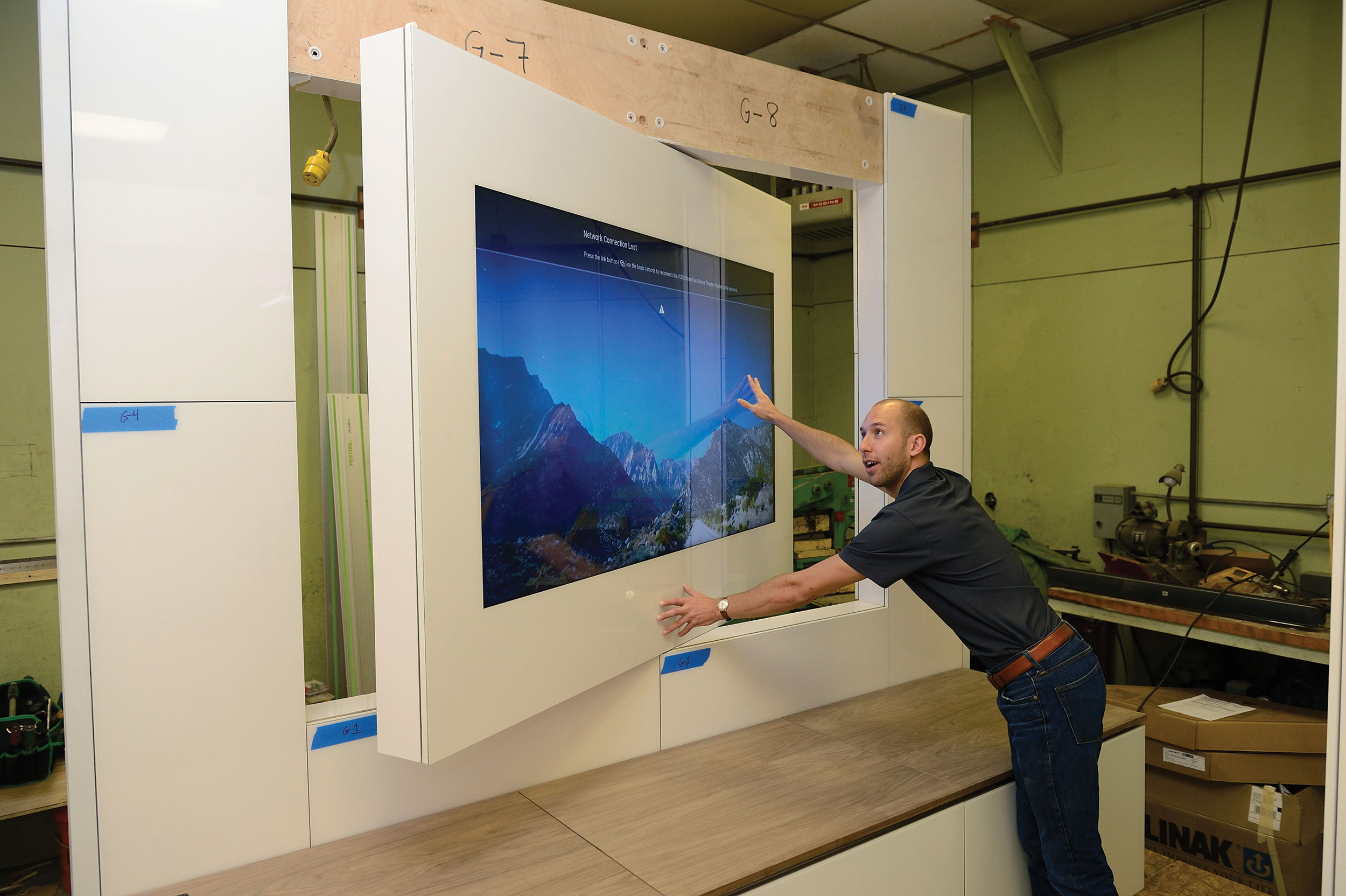
Bobby Vance ’13,’17, a principal investigator and team leader of the FutureHAUS project, installs an audiovisual wall between the office and living room. The wall, which rotates 180 degrees, functions as a speaker, television, computer screen, videoconferencing monitor, and dry-erase board on one side, while the other displays scenic photography. (photo by Jim Stroup)
Nelson Bregon, associate assistant deputy secretary for the U.S. Department of Housing and Urban Development, was effusive.“The Virginia Tech students are stepping to the forefront of technology and innovation,” he said. “I think that this concept is a concept that will be taken to scale eventually. We’ll have a product that will be very marketable—not only in this country but internationally.”
The FutureHAUS prototype was lost a month later in a fire that destroyed its construction and fabrication shop at the Prices Fork Research Station. However, the research lives on. FutureHAUS Dubai, a net-positive energy solar home will be unveiled at the Solar Decathlon Middle East in October 2018. Virginia Tech is the only U.S.-based college team invited to the worldwide competition.
The Myers-Lawson School of Construction is also leading the charge in smart construction and design, supported by leading industry partners and federal grants. The school’s projects range from research on the use of drones and robots for building inspections, to wearable technology for enhanced worker safety, to augmented reality that improves construction site efficiency. In addition to National Science Foundation and federally funded projects, the research involves industry partners, including W.M. Jordan, HITT, Hourigan Construction, Clark Construction, and the Associated General Contractors of America.
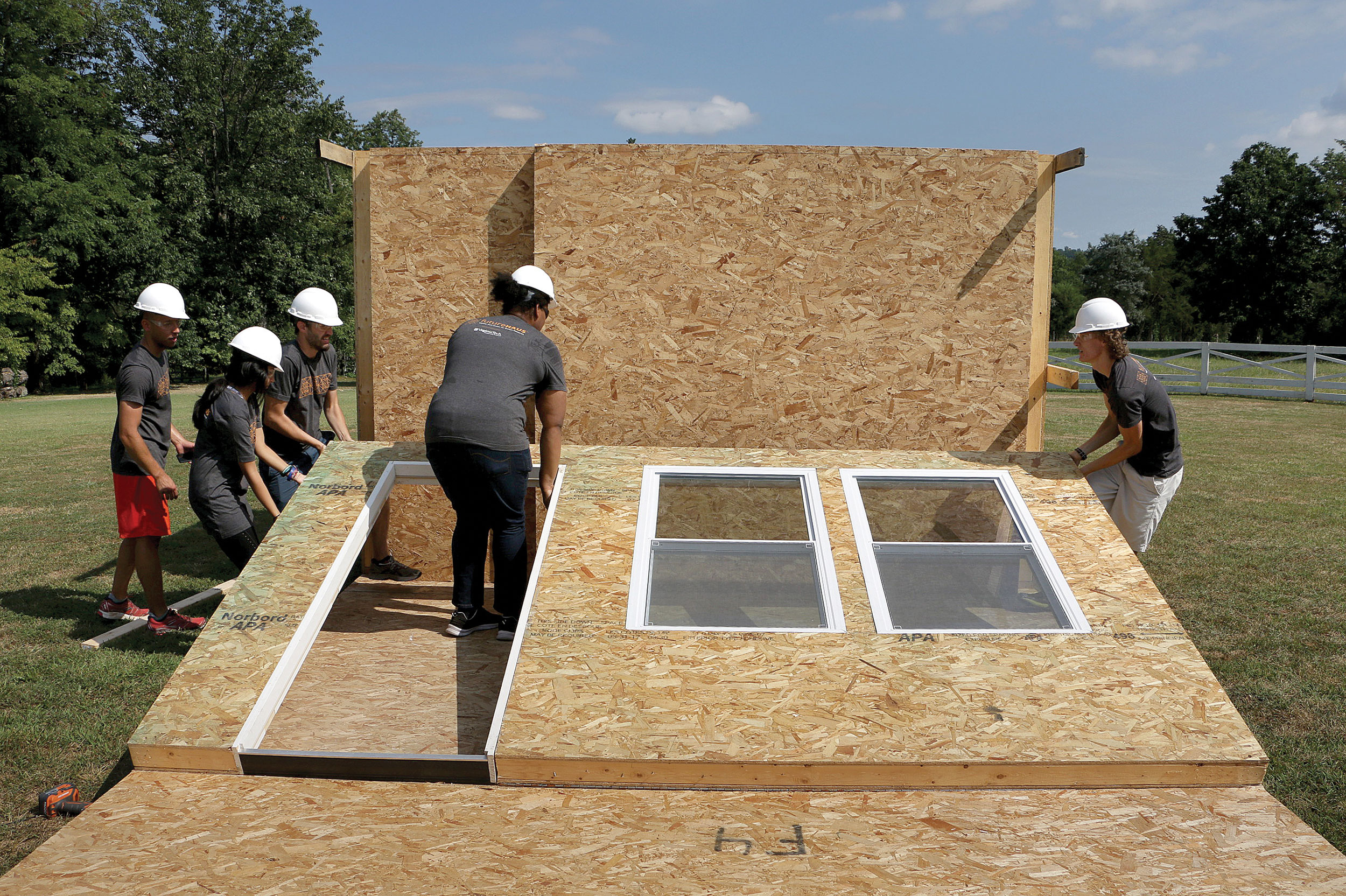
A student-led demonstration, held in July for officials from the U.S. Department of Housing and Urban Development, showcased the process for setting up a disaster relief housing prototype designed by Virginia Tech researchers. (photo by Ray Meese)
CAUS has long worked ahead of the smart construction and design curve. With Virginia Tech’s 2010 world-winning Solar Decathlon home, Lumenhaus, and, more recently, FutureHAUS, the School of Architecture + Design has brought smart, sustainable housing solutions to the world stage.
“The construction industry is ripe for incorporating new production processes and technologies,” said Brian Kleiner, director of the Myers-Lawson School of Construction. “Our faculty and students are inventing the future of construction with a human-centered approach. There is a natural assumption that increased automation yields improved productivity, efficiency, safety, and cost control.But without human-centered design, humans are left to perform ‘leftover functions’ that can be inefficient, boring, or even dangerous. Myers-Lawson is working with industry to ensure that automation supports human health and efficiency.”
In January, the team traveled to KBIS Orlando, the world’s largest kitchen and bath industry expo, to exhibit the final phase of a three-year research project presenting the smart home of the future. The team’s conceptual bedroom and home office, with their flexible spaces, moveable walls, and integrated, user-responsive technology, drew nearly 40,000 spectators during the three-day show.
Six months after Virginia Tech President Tim Sands announced an investment in intelligent infrastructure, several major donors jumpstarted the project by contributing $25 million toward construction of a $50 million, two-building Intelligent Infrastructure Complex and other projects that total about $28.45 million, including an Autonomous Systems Park, Intelligent Infrastructure Corridor, and Smart Village.
The donor group includes John Lawson (geophysics ’75), president and CEO of W.M. Jordan Company and a namesake of Virginia Tech’s Myers-Lawson School of Construction; Brett Hitt and Russell Hitt, co-president and chairman of HITT Contracting Inc.; and others.
“Virginia Tech is a national leader in construction education, but today’s fast-moving technology demands a broader view,” said Lawson. “By combining knowledge of smart construction with expertise in autonomous vehicles and energy systems, Virginia Tech can be the world’s leading source of expertise in intelligent infrastructure.”

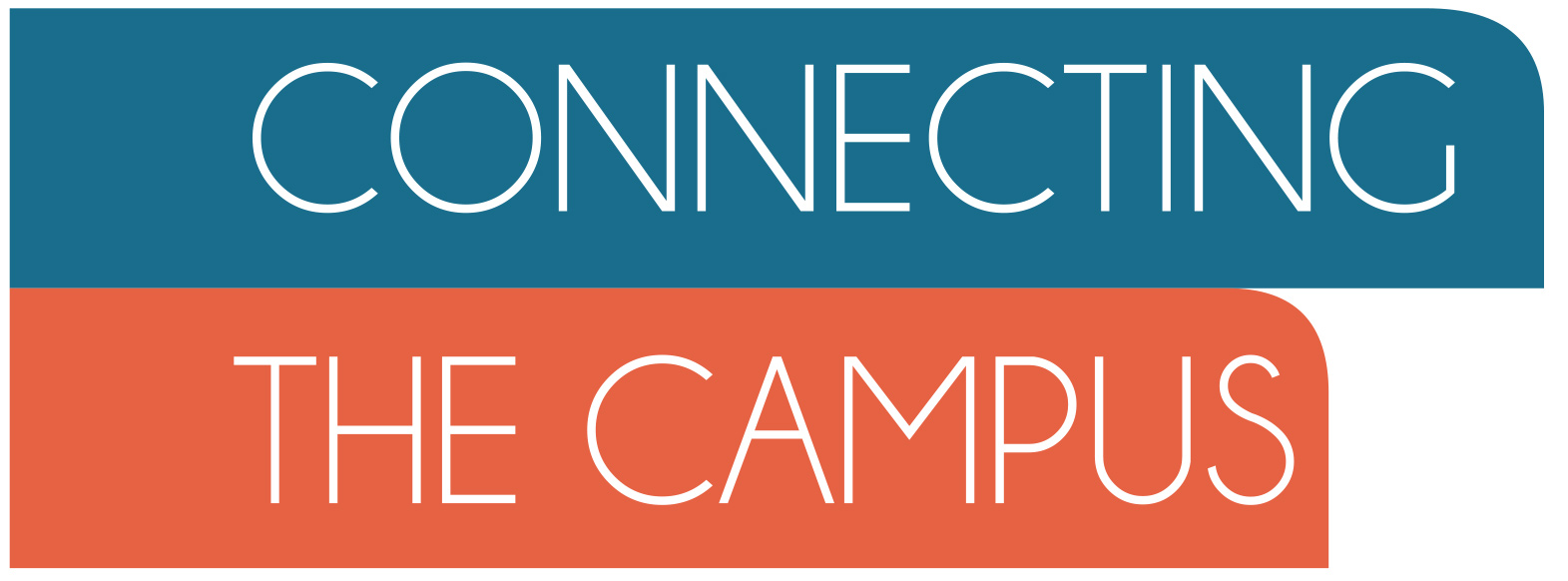
Over the next five years, Virginia Tech intends to build upon an existing network of facilities across Blacksburg to maximize opportunities for intelligent infrastructure initiatives. These additions, renovations, and expansions will be the background against which students, faculty, and university partners will discover new technologies and develop practical applications to make a meaningful impact on the quality of life in communities around the globe.
Smart Investments
The $45.5 million Intelligent Infrastructure Complex will include two new interdisciplinary research and education buildings and smart dining facilities.
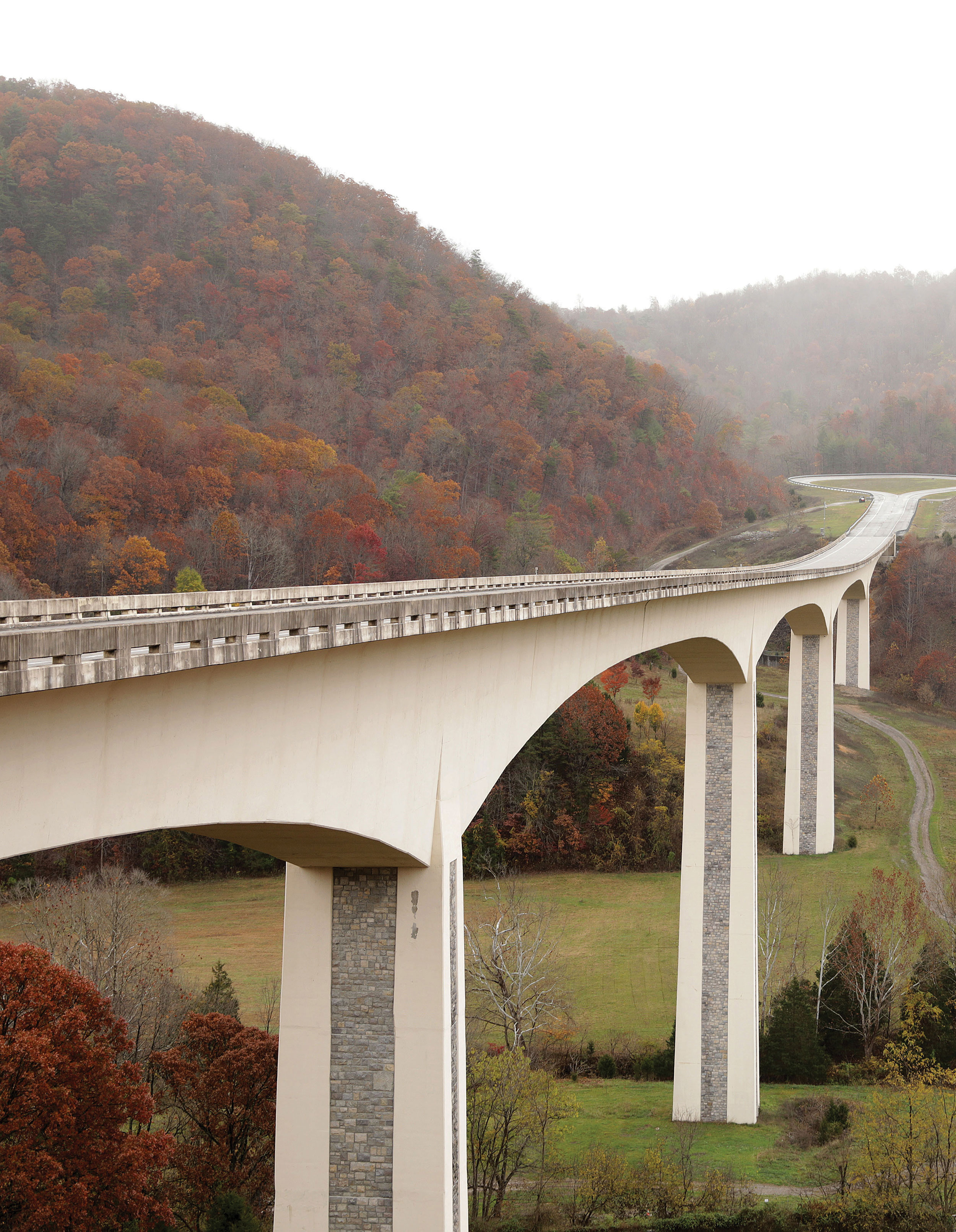
(photo by Ray Meese)
The $1 million “drone park” near the Duck Pond will provide a place for students to experiment with autonomous land vehicles and unmanned aircraft.
The $9 million Advanced Design and Construction Facility on Plantation Road will feature a hangar-like facility where faculty and students can connect basic research to practical applications in areas ranging from smart houses to smart energy.
The $2 million Automation/Intern Hub at the Virginia Tech Transportation Institute will enable students to work directly with industry leaders to drive innovation and entrepreneurship.
The $1 million Intelligent Infrastructure Corridor will connect with existing facilities on Plantation Road for automated vehicle experiments.
The $10 million Rural Roadway Expansion and a $3.5 million Surface Street Expansion, along with existing smart road facilities, will result in a test-bed for self-driving cars and unmanned aircraft systems.
The $3 million expansion at the Urban Living Lab in the National Capital Region will enhance study opportunities in the metropolitan environment.
Marya Barlow is the CAUS communications director. Eleanor Nelsen is the communications manager for the Institute of Critical Technology and Applied Science.
